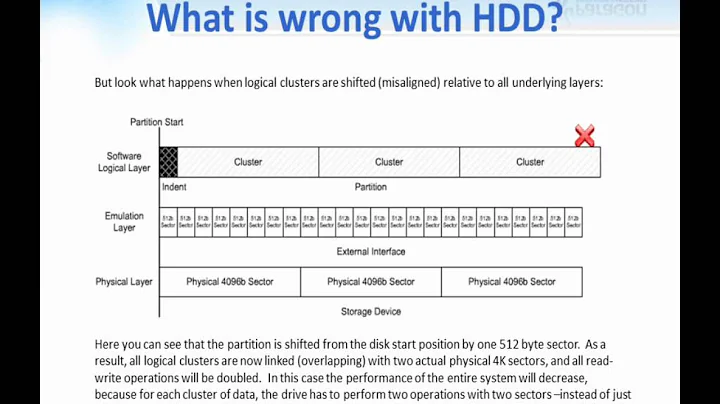Check if partitions are aligned properly for performance?
Starting partedwith the --align optimal option tells the program to align to multiples of the device's physical block size to ensure best performance.
The --align option has other types available as well.
See man parted for more information.
Related videos on Youtube
its_me
Updated on September 18, 2022Comments
-
its_me over 1 year
I just created a GPT disk label for the entire space on my hard disk (
/dev/sda) like so:# parted (parted) select /dev/sda (parted) mklabel gpt Warning: The existing disk label on /dev/sda will be destroyed and all data on this disk will be lost. Do you want to continue? Yes/No? Y (parted) mkpart primary 0% 100% Warning: The resulting partition is not properly aligned for best performance. Ignore/Cancel? I (parted) quitUpon further reading now, I realized that 'ignoring' was probably a bad idea w.r.t performance.
But...
# parted (parted) print Model: ATA ST33000650NS (scsi) Disk /dev/sda: 3001GB Sector size (logical/physical): 512B/512B Partition Table: gpt Number Start End Size File system Name Flags 5 1049kB 2097kB 1049kB bios_grub 1 2097kB 8592MB 8590MB raid 2 8592MB 9129MB 537MB raid 3 9129MB 43.5GB 34.4GB raid 4 43.5GB 3001GB 2957GB raid (parted) align-check optimal 1 1 aligned (parted) align-check optimal 2 2 aligned (parted) align-check optimal 3 3 aligned (parted) align-check optimal 4 4 aligned (parted) align-check optimal 5 5 aligned (parted)So
partedhas aligned the partitions by itself?align-check optimal *says so.If that's not the case, how do I check if the disk's partitions need to be re-aligned for performance? And how do i go about doing that?
If that's indeed the case,
mkpart primary 0% 100%actually automates the process of aligning partitions in all cases? Any edge cases where it wouldn't?
-
Tom Hunt over 8 yearsModern disks are best aligned to a 4k boundary, IIRC, and many tools will align to 1M by default in order to allow more easily for abstractions like LUKS/mdraid/LVM. I'm not wholly familiar with
partedoutput, but it does appear that the partitions there are misaligned at 4k. Meanwhile, the only way to realign the partitions is to delete and recreate them. -
Tom Hunt over 8 yearsI've only ever done this with
fdiskorgdisk. They both handle alignment automatically by default, and it'll be aligned correctly so long as you specify partition lengths in large units (gigabytes, usually). I have no idea how to do it withparted. -
its_me over 8 years@TomHunt I think
parteddoes it automatically too. I've added details in my question to show the same.
-
 Daniel F about 3 yearsWhat I don't understand is why, if I then use
Daniel F about 3 yearsWhat I don't understand is why, if I then usemkpart primary 0% 100%, the partition starts at 33.6 MB. That is a lot more than multiples of 512B ( Sector size (logical/physical): 512B/512B with Partition Table msdos )







